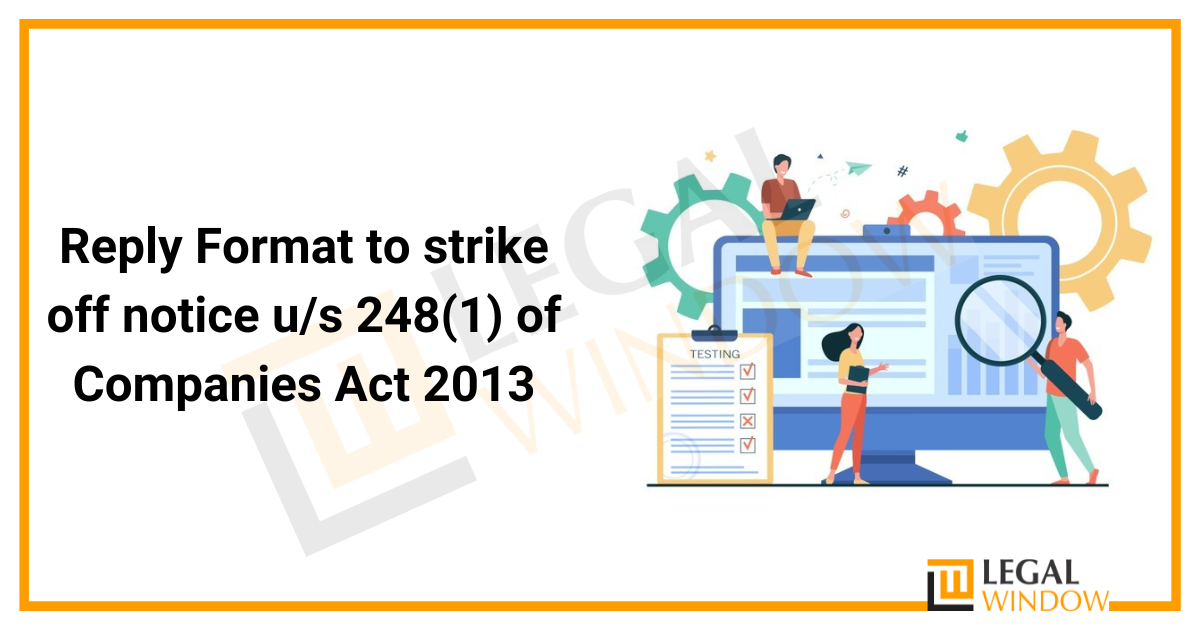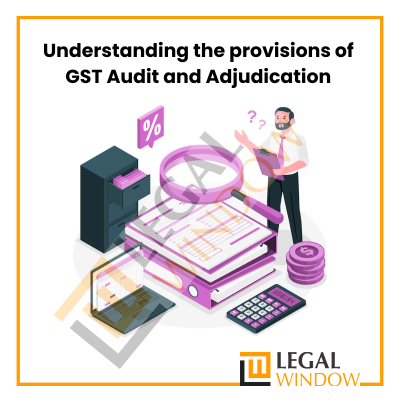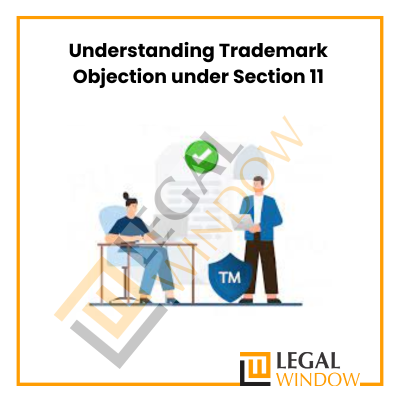Reply Format to strike off notice u/s 248(1) of Companies Act 2013
- September 20, 2022
- Company Law
 If the company does not start operations within one year or the company does not carry out any business activity for 2 years, then in such a case, following the provisions of Section 248, sub-section 1 of the Companies Act, the ROC may issue a notice to the company to delete the company name from the commercial register. The notice so issued by the ROC is commonly known as a cancellation notice. So let us have a quick look at the format of the reply to strike off notice u/s 248(1) of the Companies Act 2013.
If the company does not start operations within one year or the company does not carry out any business activity for 2 years, then in such a case, following the provisions of Section 248, sub-section 1 of the Companies Act, the ROC may issue a notice to the company to delete the company name from the commercial register. The notice so issued by the ROC is commonly known as a cancellation notice. So let us have a quick look at the format of the reply to strike off notice u/s 248(1) of the Companies Act 2013.
What is Section 248(1)?
According to the powers conferred on the ROC through the provisions of Section 248 (1) of the Companies Act, the ROC may issue a notice of intention to strike off a company (i.e. remove the name of a company from the register of companies) under the following circumstances:
- If the company does not start its business activity within one year from the date of its establishment; or
- If the company does not carry out business activities for two years and has not applied for the status of a dormant company within this period.
Generally, failure to submit financial statements and annual returns for the previous two financial years is the basis for the intention to issue a cancellation notice by the ROC.
Brief understanding of ROC-initiated strike-off process
Under the provisions of Section 248(1) of the 2013 Act read with Rule 3(2) of the Companies (Deletion of Company Names from the Register of Companies) Rules, 2016 (or the Rules), the ROC shall send a notice to the company and all directors individually in Form STK-1 on which such company and director(s) shall have an opportunity to reply to such notice and raise their objections to such intention of the ROC within 30 days of receipt of such notice. If the ROC does not receive any response within the specified period, it will further issue a public notice in the form of STK-5, after which the status of the company will change from “Active” to “In the process of striking off” and a period of 30 days will be provided for a response again. The second step of the ROC is to inform the stakeholders/general public about such stacking to get any objections from them. Publish such a 30-day period after STK-5, in case no objections or submissions are made by any of the interested parties, ROC will proceed to publish STK-7 in the official gazette and delete the company name.
Stages of response to the notice of revocation
- According to the provisions of Section 248(1) of the 2013 Act as amended by Article 3(2) of the relevant rules, it primarily appears that the directors and the company will be allowed to submit a request for their representations within 30 days from the date of such notice STK-1 and not at any time thereafter. There is a time when the status of the company remains “active”.
- Furthermore, following Section 248, sub-section 4, a notification in the form of STK-5 will be published, the relevant regulatory authorities will be notified at the same time, and an additional period of 30 days will be provided for submitting objections. This is the time when the status of the company changes from “Active” to “In Process of Strike”.
- It may happen that the directors do not have time to submit an answer to the STK-1, but the ROC learns of such an intention through the STK-5 and there is a question of whether the directors and the company can also submit an answer to such an STK-5, or only the general public has the right to do so, and the rights of the director/company expire if he does not submit an answer to STK-1.
Reply to strike off notice
Upon receipt of a notice of strike, the relevant company is required to provide an appropriate response within 30 days from the date of receipt of the notice. The Company may also take the following actions based on intent:
Continue operations
If the company wishes to continue its business, in such case the company must file all pending returns and annual returns together with payment of all penalties and other fees upon receipt of the notice. After filing all pending returns and declarations as required by law, the company is required to file an appropriate response to the notice received within one month of receiving the notice. Upon receiving the response, the registrar may conclude to his satisfaction that the company name will not be deleted from the commercial register and terminate the proceedings accordingly.
Discontinue Operations
If the company does not wish to continue in operation thereafter, the company is required to first file all pending declarations and annual returns as required by law, together with all fines and other charges. If the company does not want to continue and after completing all outstanding statements and returns, the company can submit a request in form STK-2 to delete the name of the company. After filing Form STK-2, the company must respond to the notice received by informing the ROC that all outstanding annual filings have been completed and since the company does not want to proceed, it has filed an application in Form STK-2 was filed. Upon receipt of the application in the STK-2 form and after receiving the response, the registrar will remove the company name from the company register.
Format of Reply to strike off notice u/s 248(1) of Companies Act 2013
Date: DD/MM/YYYY
To,
The Registrar of Companies,
“STATE”
“ADDRESS OF ROC”
Sir,
Sub: Reply to strike off notice u/s 248(1) of the Companies Act 2013 in form STK -1
Letter No.: “XYZ” dated “DD/MM/YYYY”
Reference: In the matter of XYZ Private Limited
Regarding the above-mentioned subject, we hereby inform you that the board of XYZ Private Limited (“Company”) (CIN: ) having its registered office situated at “Registered office address of the company” has commenced the business and the subscribers to the memorandum have paid the subscription amount which they have undertaken to pay at the time of incorporation of the company and a declaration to this effect has been filed under subsection (1) of section 10A via INC 20-A on “date of filing of INC 20-A vide SRN “SRN” with late fees of which the receipt has been attached.
It is further required to be noted that the directors have agreed and stated on record that the company would comply with the provisions of the Companies Act within the due time frame as prescribed for upcoming compliances.
We request your good office to kindly accept the letter and not proceed with the Strike off the company under The Companies Act 2013.
Kindly acknowledge the receipt of these documents and help us by not striking off the company.
Thanking you.
For and on behalf of XYZ Private Limited
DIRECTOR 1 Director- DIN
DIRECTOR 2 Director- DIN
With this clarification/reply to notice (printed on the letterhead of the company) attach a copy of the notice received, challan of INC 20-A, and relevant attachments, if any, and to be registered post to the concerned ROC.
Deadline for filing a representation
According to Section 248(1) of the 2013 Act, the company and directors were primarily given a deadline of 30 days for filing a statement. In case the representation is not made within the above period, STK-5 notice has been published on the MCA website, official gazette, and two newspapers (one English and one vernacular). It may be the possibility that directors and companies have not made a representation after receiving STK-1 or are unable to submit a representation due to non-receipt. In these cases, there is still a right to make a representation, and the directors and/or the company can make that representation after STK-5 is published.
 Final words
Final words
In case your company has received such notice (STK-1 or 5), it is advisable to file the relevant reply/statement with ROC as soon as possible and put the reasons on record to protect your company from penalty. . And even if you do not file an answer within 30 days from STK-1, you must immediately proceed to file a statement. It will also be necessary to save your company costs and avoid unnecessary hurdles in updating the compliance and it will also reduce the number of cases before the Hon’ble NCLT. Ultimately, it is always better to approach the right authority at the right time to protect the interests of the company and its stakeholders.
Legal Window has professional experts that can guide you through this process of replying to strike-off notice u/s 248(1) of Companies Act 2013. We draft, assist, and help to send the notice to ROC. Connect us if you want any assistance in the reply notice.
CS Urvashi Jain is an associate member of the Institute of Company Secretaries of India. Her expertise, inter-alia, is in regulatory approvals, licenses, registrations for any organization set up in India. She posse’s good exposure to compliance management system, legal due diligence, drafting and vetting of various legal agreements. She has good command in drafting manuals, blogs, guides, interpretations and providing opinions on the different core areas of companies act, intellectual properties and taxation.
Categories
- Agreement Drafting (23)
- Annual Compliance (11)
- Change in Business (36)
- Company Law (147)
- Compliance (89)
- Digital Banking (3)
- Drug License (3)
- FEMA (17)
- Finance Company (42)
- Foreign Taxation (6)
- FSSAI License/Registration (14)
- GST (118)
- Hallmark Registration (1)
- Income Tax (199)
- Latest News (34)
- Miscellaneous (164)
- NBFC Registration (8)
- NGO (14)
- SEBI Registration (6)
- Section 8 Company (7)
- Start and manage a business (20)
- Startup/ Registration (126)
- Trademark Registration/IPR (40)
Recent Posts
- Maximise Your Tax Savings: Power of Form 12BB April 23, 2024
- Cryptocurrency startups and Regulatory compliance April 22, 2024
- Understanding the provisions of GST Audit and Adjudication April 20, 2024
About us
LegalWindow.in is a professional technology driven platform of multidisciplined experts like CA/CS/Lawyers spanning with an aim to provide concrete solution to individuals, start-ups and other business organisation by maximising their growth at an affordable cost.







